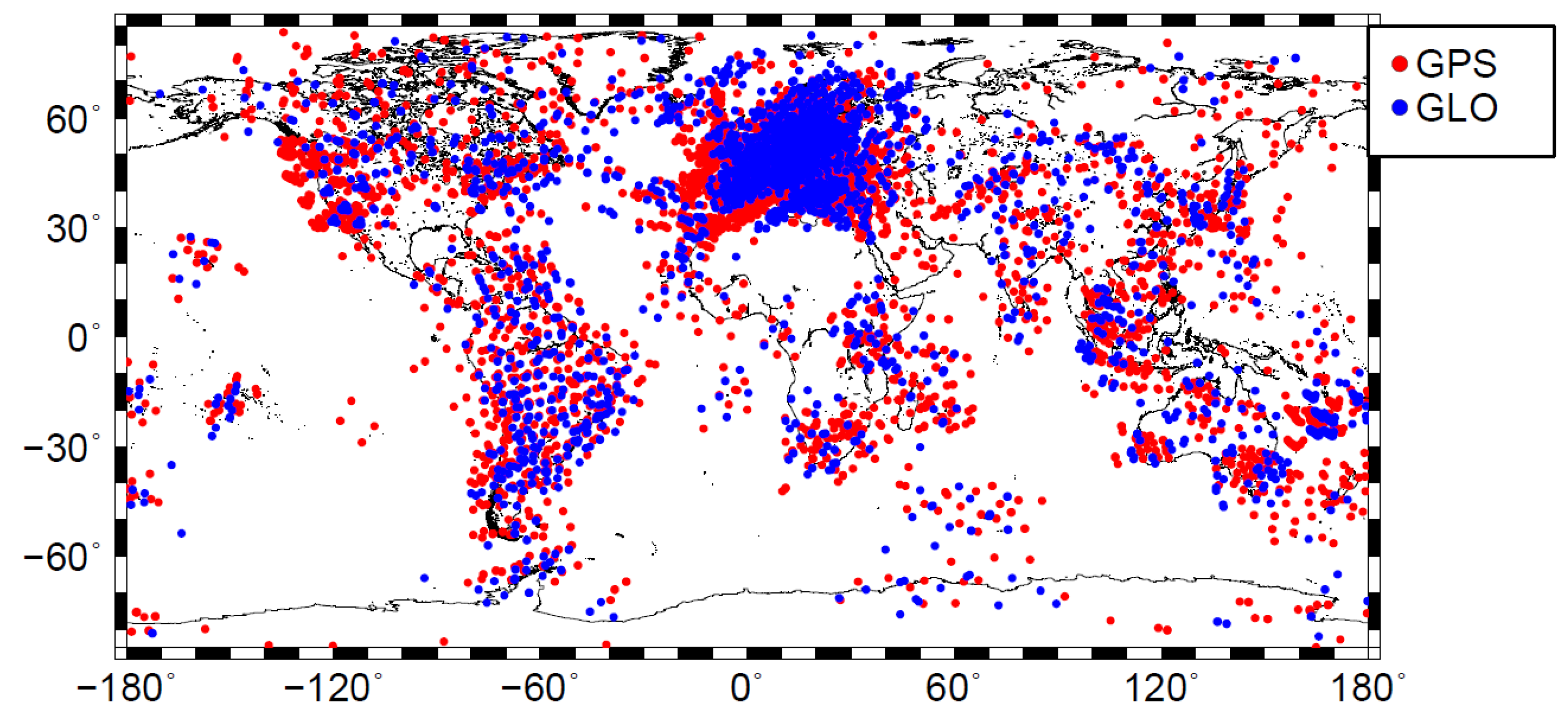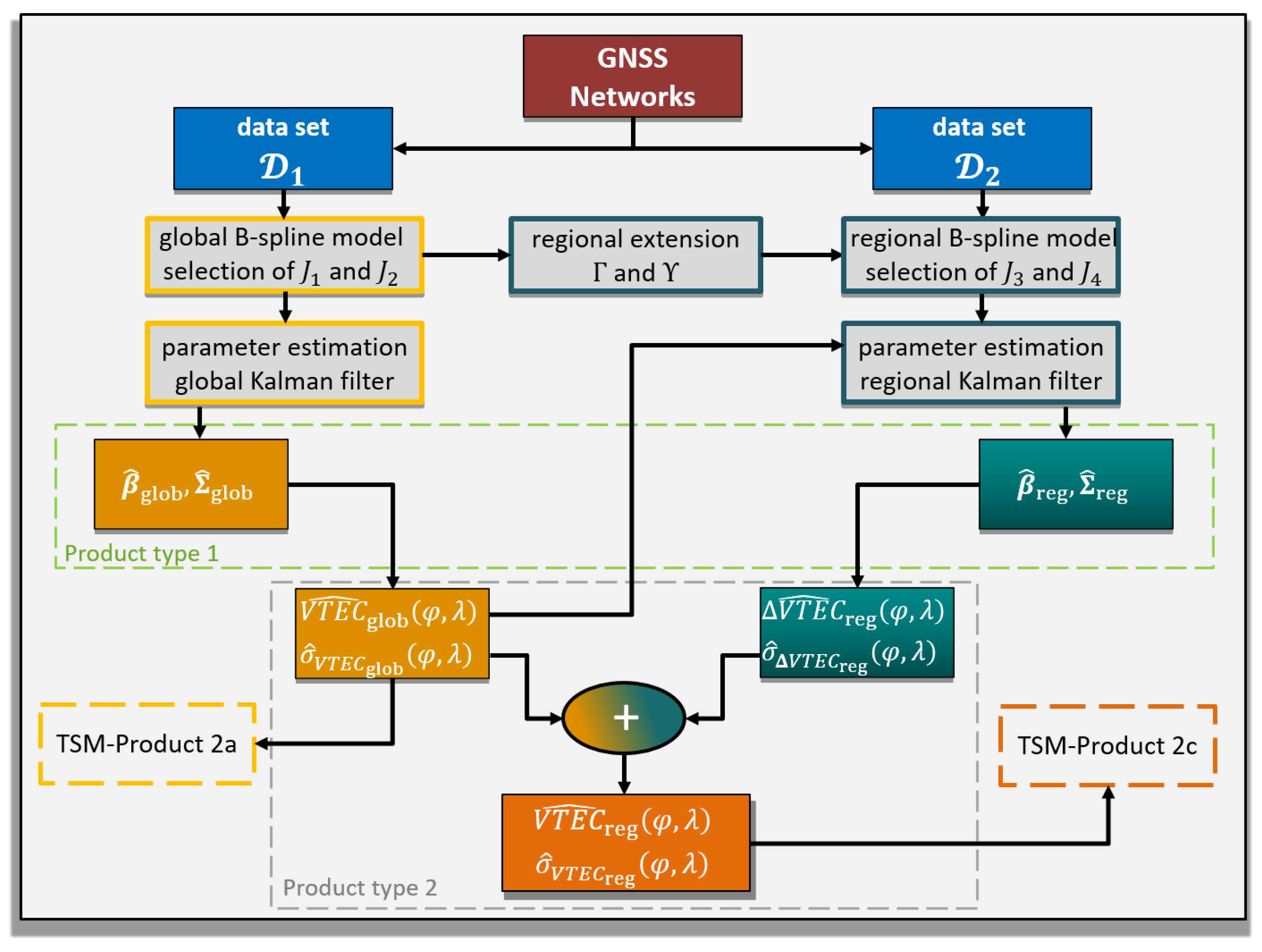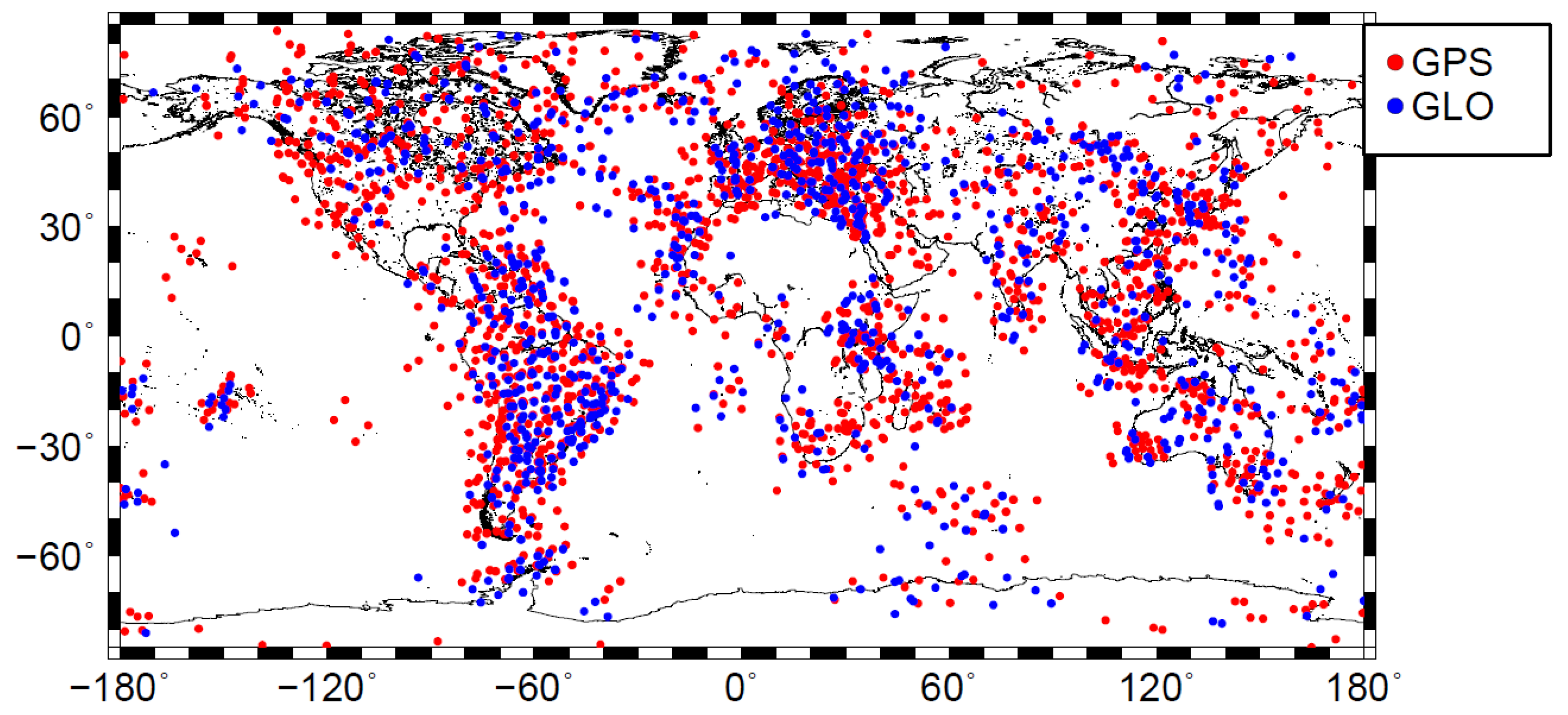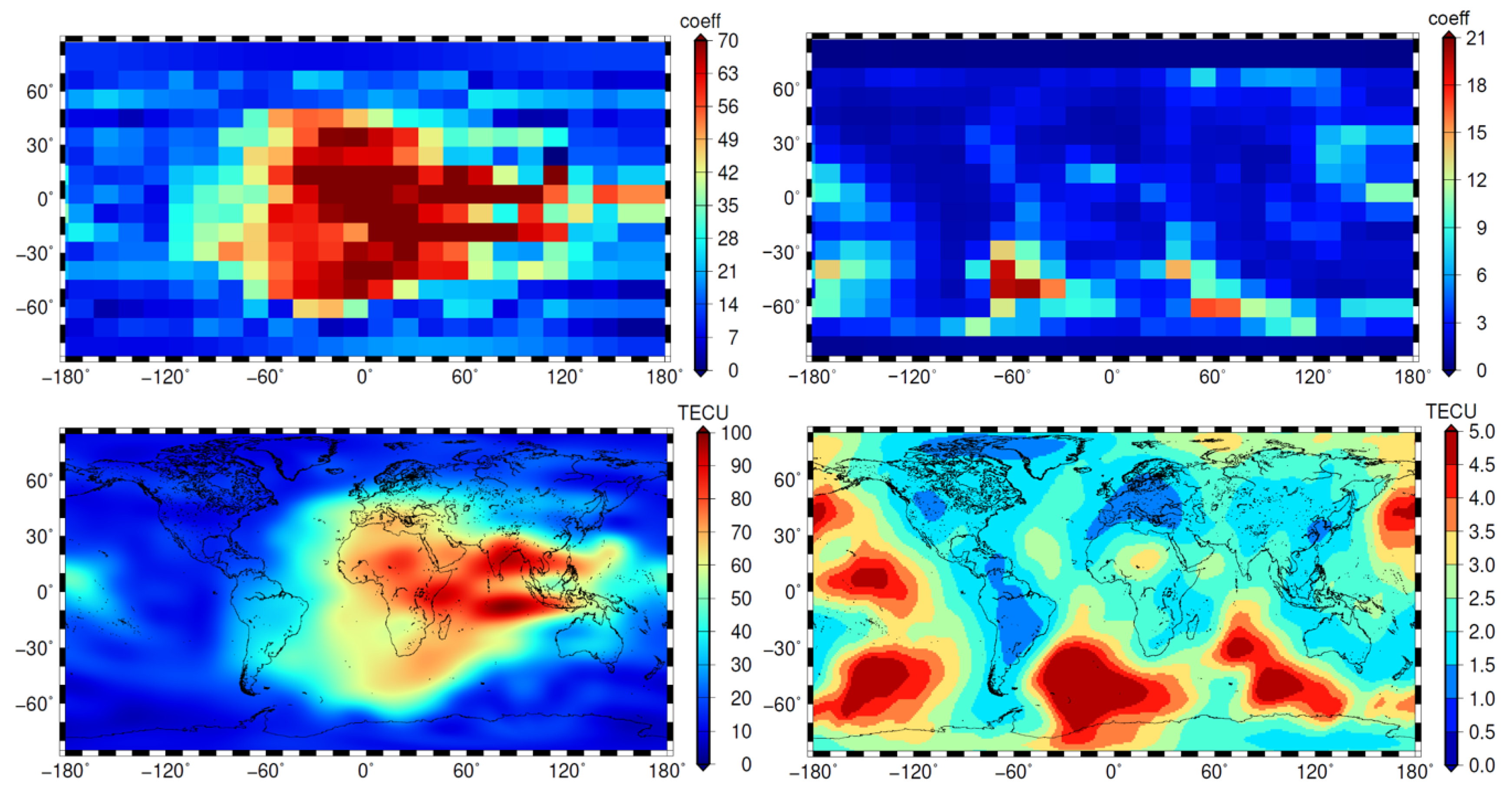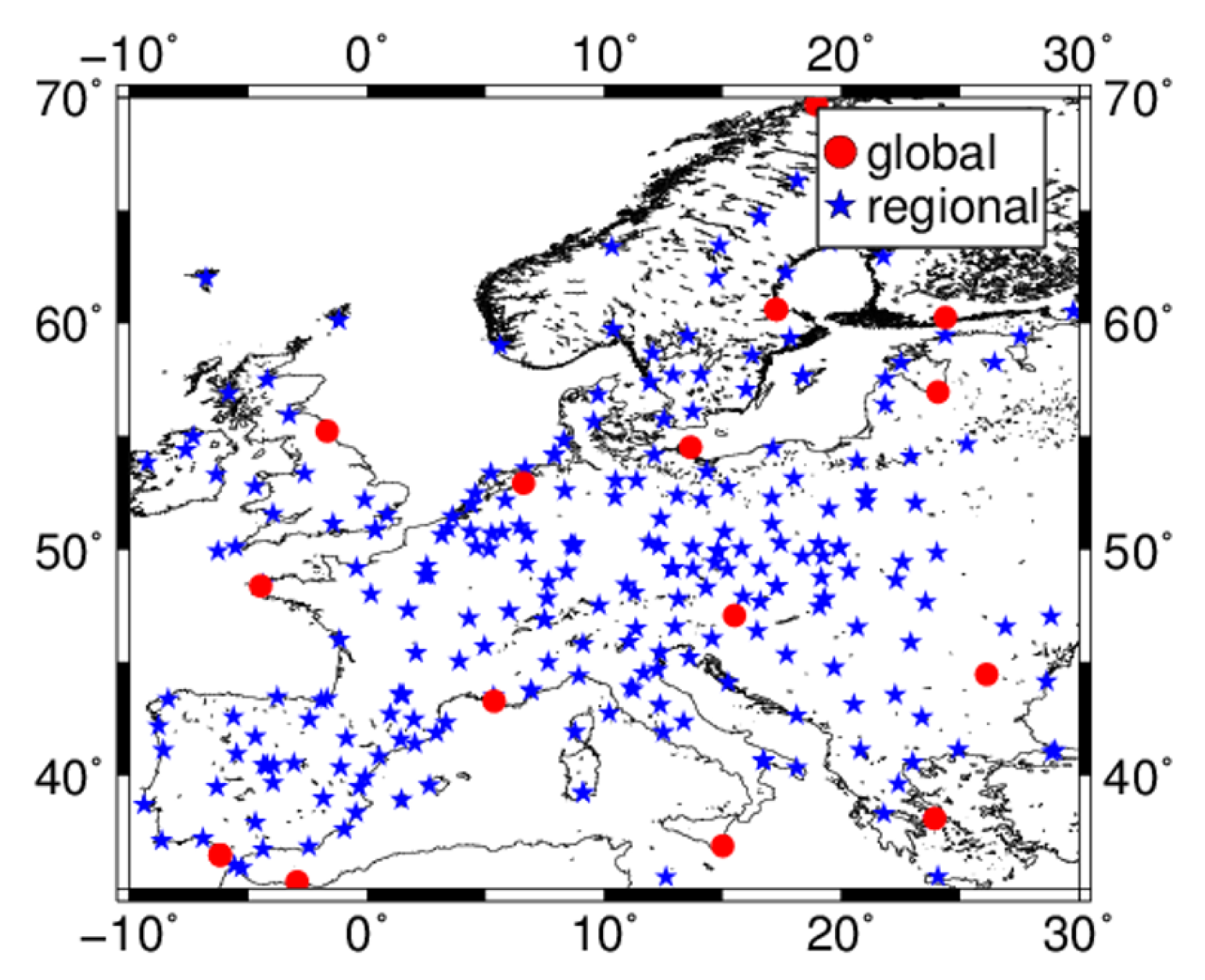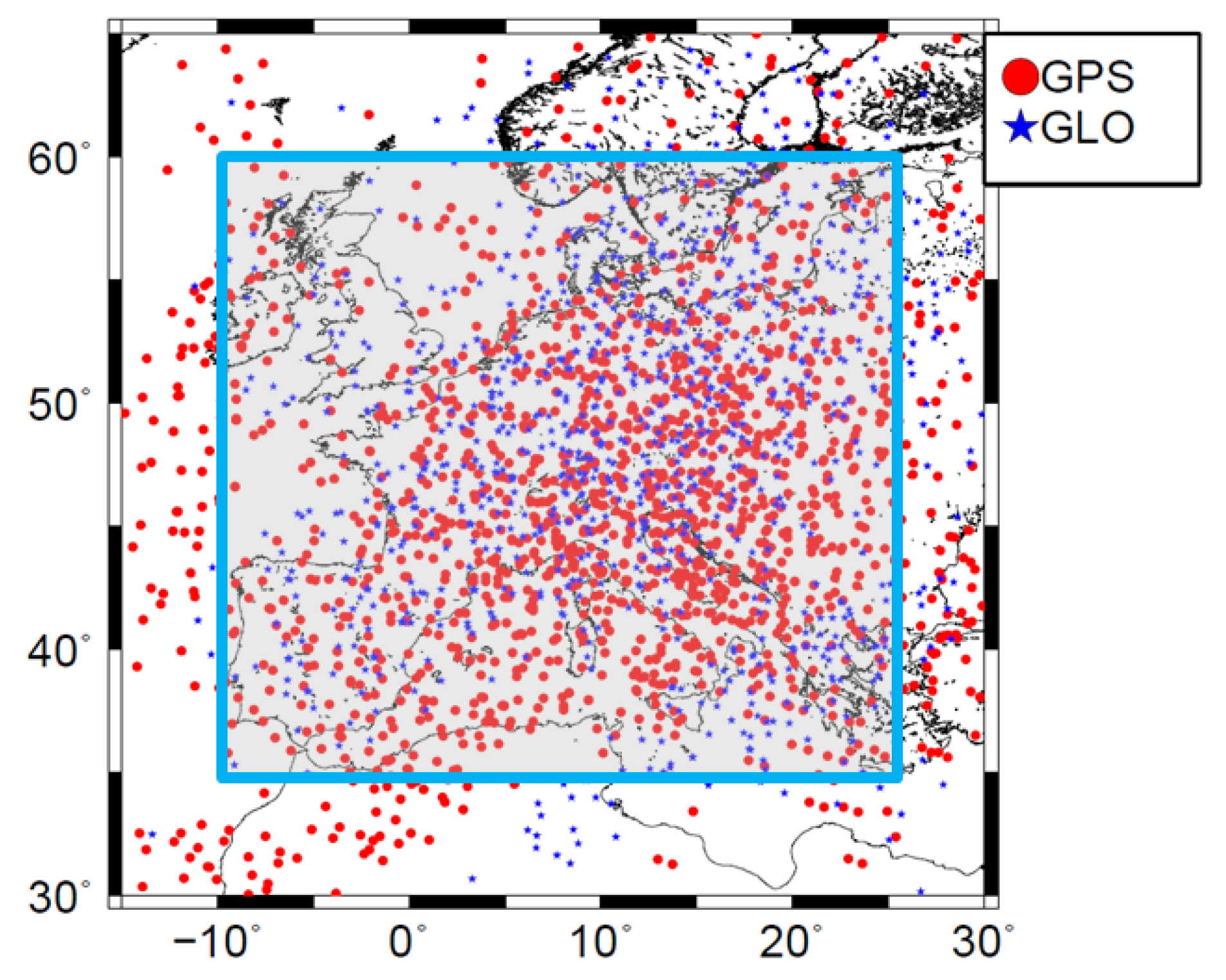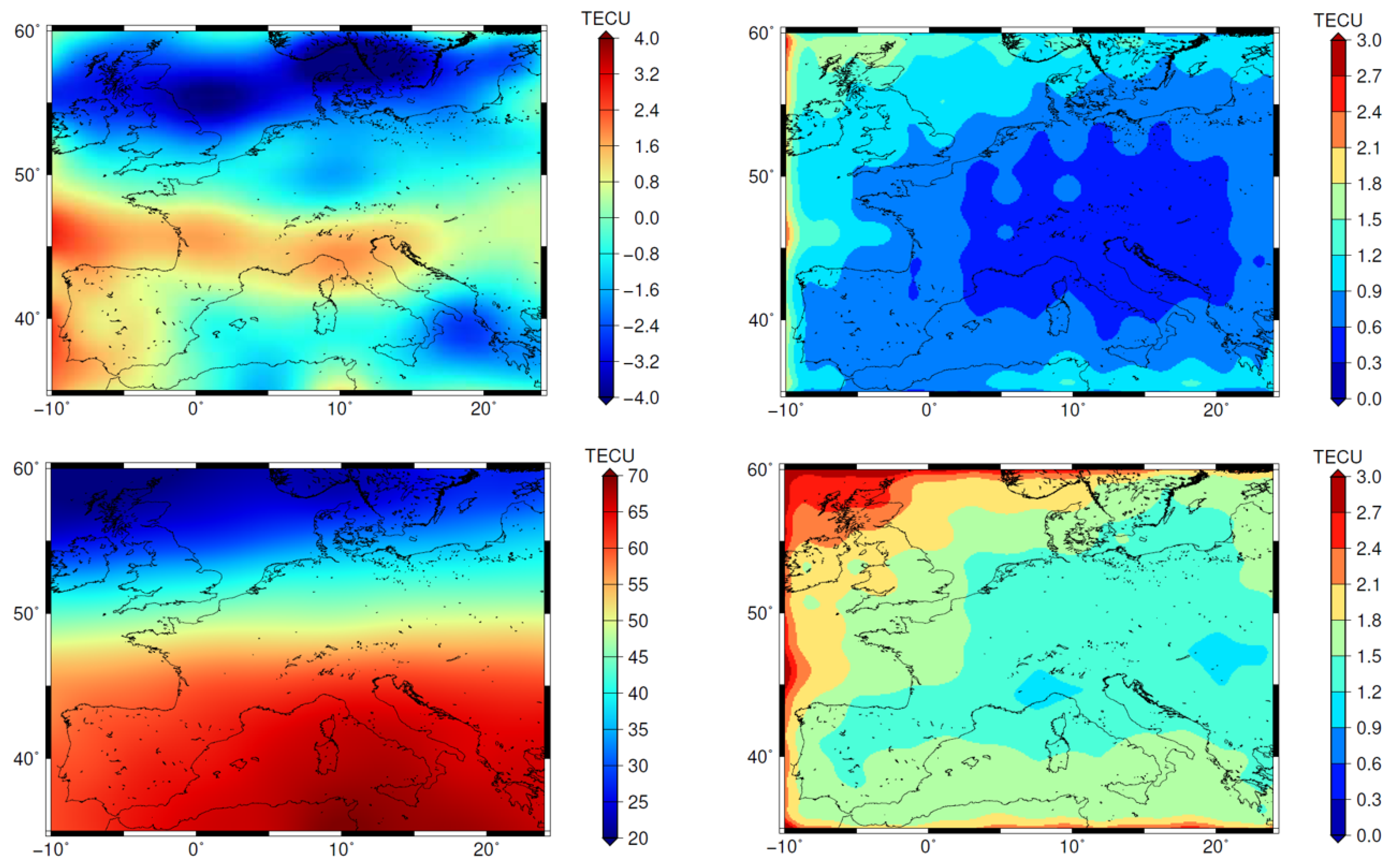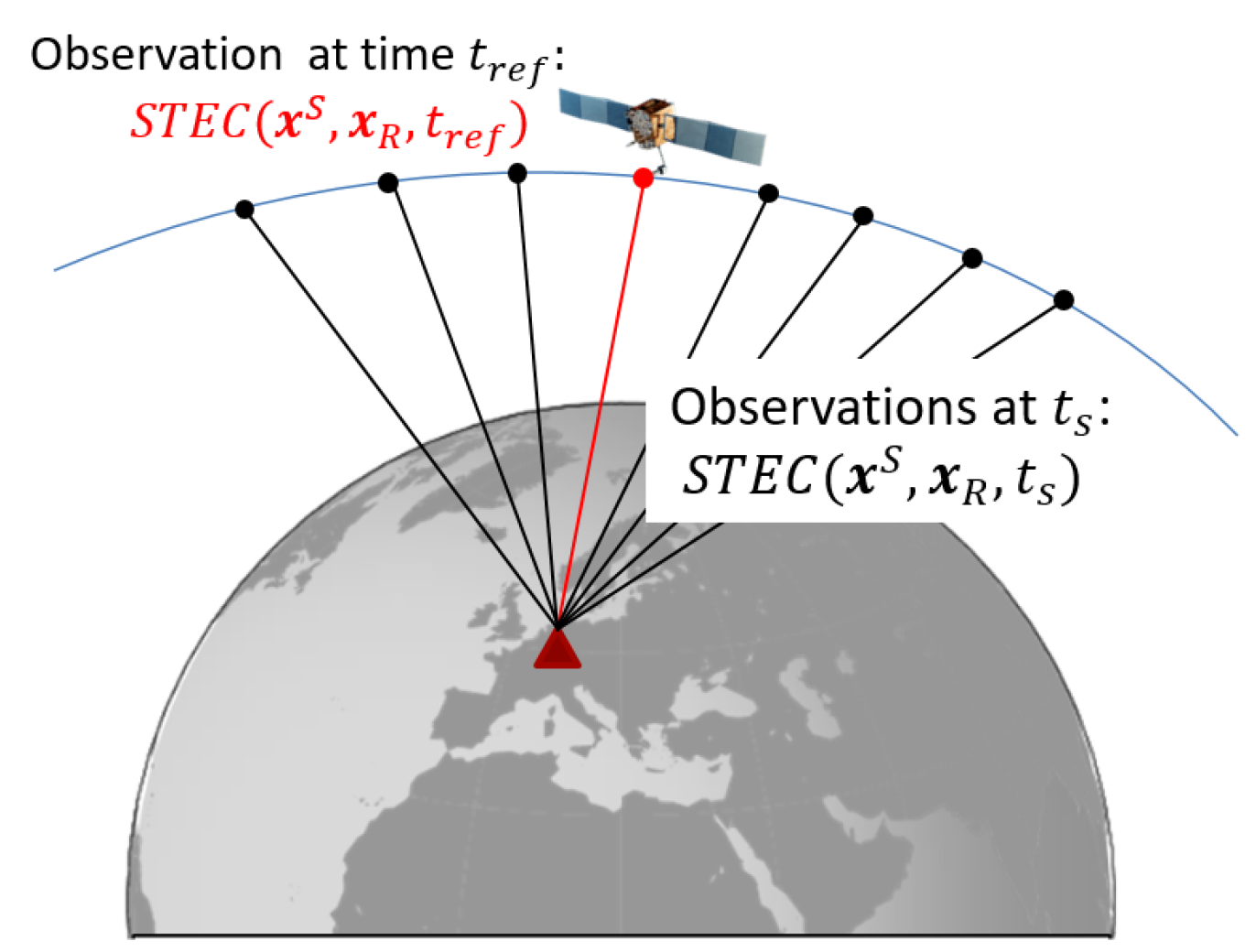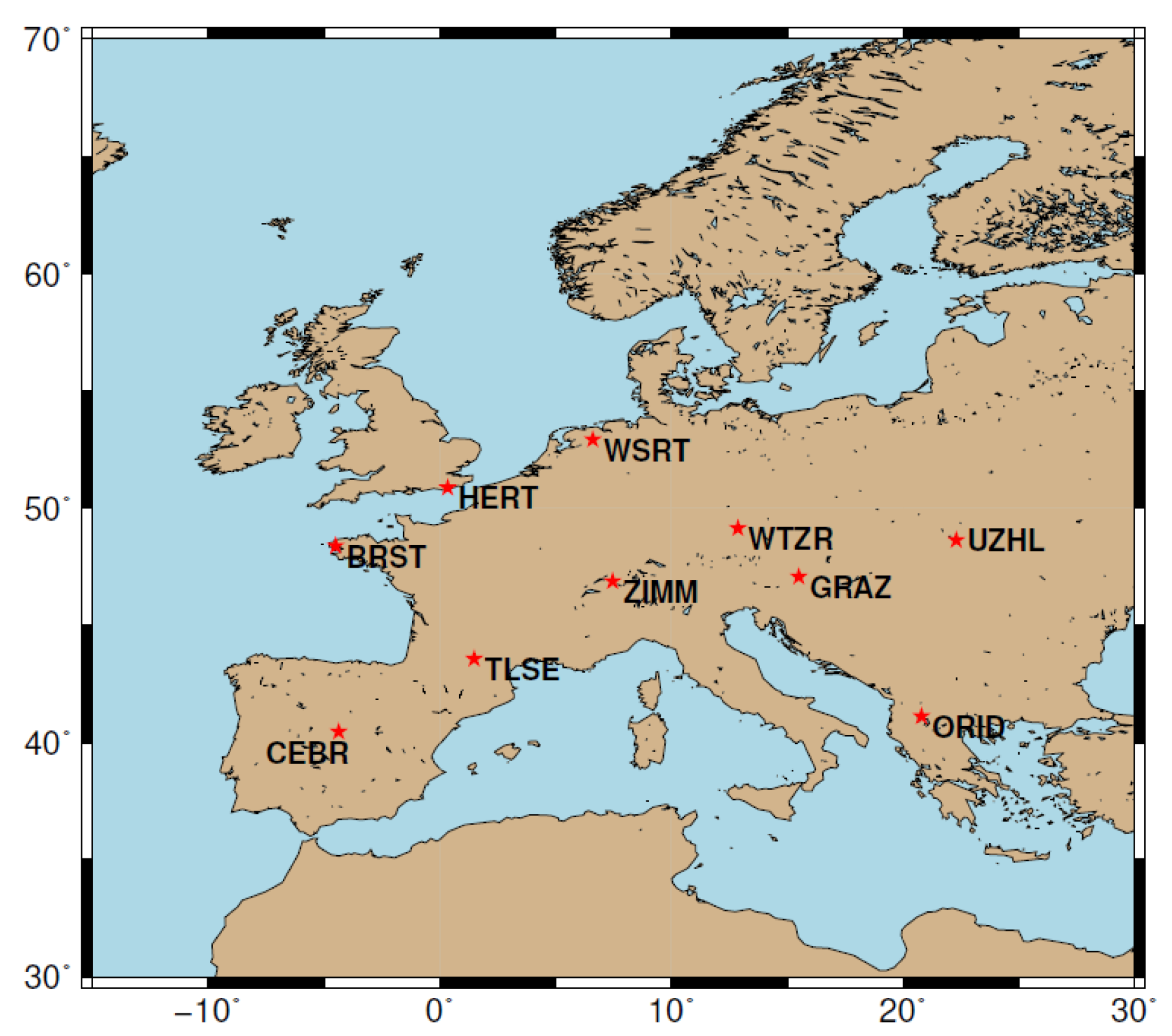1. Introduction
In the last decades, the use of GNSS for a broad range of commercial and scientific fields has significantly increased. Especially GNSS applications which rely on high precision positioning and navigation became more and more popular. With higher demands on accuracy, the requirements for detecting and correcting errors in the measurements increase. The main error sources in precise GNSS are the effects caused by the atmosphere. Whilst the tropospheric effects can yield approximately 1m error in positioning (in along range, i.e., the height), the ionosphere effects can vary between 1 m and even 100 m. The ionosphere is defined as the part of the upper atmosphere where the number of charged particles (electrons and ions) is high enough to induce significant changes in the propagation of radio waves. The effect mainly depends on the signal frequency; signals with frequencies lower then 30 MHz can be blocked and reflected, signals with a shorter wavelength, however, are affected in their travel times (delay) and their signal paths (bending). The delay of the signal between the satellite S and the receiver R defined as
is only an approximation as higher-order effects are neglected. The sign on the right-hand side changes whether it is applied for carrier phase observations (‘-’) or for pseudorange measurements (‘+’) [
1]. In geodesy the delay can be interpreted in two ways, namely as a
In the latter case,
can be used as observation to determine the electron density
as the ionospheric key parameter. Among many others, e.g., ionosondes and radio occultations, GNSS is the most prominent observation technique used to gain information about
. However, GNSS is not sensitive to the electron density directly, but on the integrated effect along the ray path. It is denoted as Slant Total Electron Content (STEC) and defined as
STEC depends on the electron density
along the ray path between the position
of the satellite
S and the position
of the receiver
R for time
t. The position vector
reads
where
and
are latitude and longitude,
r is the radial distance within a geocentric coordinate system
.Many ionosphere models rely on the assumption that all electrons in the ionosphere are concentrated on a spherical shell
of infinitesimal thickness with fixed height
above the spherical Earth of radius
. It is denoted as single-layer model (SLM) and allows for the transformation of STEC into the vertical direction as
by applying a mapping function
depending on the zenith angle
z [
2]. It yields vertical total electron content (VTEC) referred to the Ionospheric Pierce Point (IPP), the intersection point of the ray-path with the shell
at the position
. Several approaches exist for the realization of the mapping function; recently UPC developed the Barcelona Ionospheric Mapping Function (BIMF) [
3]. Besides the electron density VTEC means another ionospheric key parameter which can be represented as the integration,
of the electron density along the height between the lower boundary
and the upper boundary
of the ionosphere.
There are several approaches for representing VTEC globally by using input data from GNSS. The Ionospheric Associated Analysis Centers (IAAC) of the International GNSS Service (IGS), namely (1) the Jet Propulsion Laboratory (JPL), (2) the Center for Orbit Determination in Europe (CODE), (3) the European Space Operations Center of the European Space Agency (ESOC), (4) the Universitat Politècnica de Catalunya (UPC), (5) the Canadian Geodetic Survey of Natural Resources Canada (NRCan), (6) the Wuhan University (WHU) and (7) the Chinese Academy of Sciences (CAS) routinely provide Global Ionosphere Maps (GIM) representing VTEC based on different mathematical approaches, namely the series expansion or the discretization technique. Whereas in the latter case, usually pixels or voxels are chosen [
4], in the case of a series expansion spherical harmonics (SH) are mostly used. The GIM products of the IAACs are also used to generate an IGS GIM as a combined solution [
5].
As a matter of fact, the representation of VTEC on a global scale suffers from the inhomogeneous distribution of the input data which does not allow a high-resolution representation on a global scale [
6]. Capturing this inhomogeneity, the maximum degree of SHs is generally set to
. The GIMs are usually provided in IONosphere Map EXchange (IONEX) format with a temporal resolution of 2 h and a spatial sampling of
with respect to latitude and longitude and with a latency of more than one week [
7,
8].
Goss et al. [
9] developed an approach based on B-spline basis functions and a Multi-Scale Representation (MSR) which allows to model VTEC globally with a higher spectral resolution. B-splines have already proven to be suitable basis function for representing global VTEC [
10,
11,
12]. However, as a matter of fact, finer ionospheric structures can only be monitored and modeled where high-resolution input data are available, i.e., in continental regions such as Europe and North America, where a large number of stations of the global network of the IGS are located. Some of the continental regions are also covered with additional stations from regional networks, e.g., EUREF for Europe, AFREF for South Africa, ARGN and SPRGN for the Australian and Pacific region.
Figure 1 shows all IPPs collected at 12:00 UT from the receiver stations of IGS and EUREF. Due to the coverage of observation stations over Europe, a dense cluster of observations is available.
The Royal Observatory of Belgium (ROB) [
13], for instance, provides Regional Ionospheric Maps (RIM) for the European region. Besides this, there are several approaches for the regional representation of VTEC, e.g., regional B-spline expansions [
10,
14,
15,
16], the thin plate spline (TPS) interpolation [
17], the Taylor series [
18] and the SH expansion using a spherical cap coordinate system [
19].
In this paper, we describe a procedure to represent VTEC for regions with dense data coverage with high spatial and spectral resolution based on a two-step strategy using B-spline basis functions. In the first step, we apply a global B-spline model with polynomial B-splines for latitude and trigonometric B-splines for longitude in order to represent the long-period VTEC part globally. In the second step, we perform a densification into regions with dense data coverage by using the global model as background and estimating B-spline coefficients of tensor products of polynomial B-splines representing the finer structures of VTEC. In combination, the model allows for a high-resolution VTEC representation within the densification regions. The developed approach is denoted as two-step model (TSM).
The paper is outlined as follows: in
Section 2 a general description of the modelling of VTEC is given. Additionally in
Section 2.1, the two-step model, based on B-spline basis functions and the connection between the two modelling steps is derived.
Section 2.2 comprises a detailed description of the estimation of the unknown model parameters using a Kalman filter. Furthermore, in
Section 2.3 the products of the TSM are defined. In
Section 3 the TSM is applied to the European region during the St. Patrick storm days in March 2015 with a detailed validation in
Section 4.
2. Modelling Strategies for the Regional VTEC Representation
A 3-D function
, as introduced in Equation (
5), can be represented by means of a series expansion as
wherein
are given space-dependent basis functions and
are the corresponding time-dependent series coefficients. Assuming that
observations
of VTEC are given at IPP positions
with
and discrete time moments
with
and
being a given temporal sampling interval, the observation equation can be written as
with
being the measurement errors of the observations. Note, in the sequel of this paper, if not stated otherwise, we omit additional unknown parameters such as the satellite and receiver biases, i.e., Differential Code Biases (DCB) for the geometry free observations as on the right-hand side of Equation (
7).
2.1. Two-Step B-Spline Expansion
At DGFI-TUM we rely on a two-step VTEC model (TSM) in terms of B-splines. The basic equation
yields VTEC within the region of interest as the sum of the global model part
(first step) and the regional model part
(second step).
2.1.1. Global B-Spline Model
For global VTEC modelling we rewrite Equation (
7) as
with
initially unknown time-dependent series coefficients
and the tensor products
of polynomial B-spline functions
and trigonometric B-spline functions
representing VTEC w.r.t. latitude
and longitude
; for more information see [
9,
20,
21,
22,
23]. The shift parameters
and
for polynomial and trigonometric B-splines, define the position of the B-spline functions on the sphere
. The total numbers
and
of B-spline functions depend on the B-spline levels
and
. In order to select appropriate numerical values for
and
, the two inequality chains
have been considered by Goss et al. [
9] and relate
and
to the average global sampling intervals
and
of the input data, i.e., the GNSS measurements, and the maximum degree
of a SH expansion, which means the measure for the spectral content of a signal given on a sphere.
For the numerical values 1 to 6 for the B-spline levels
and
,
Table 1 presents the corresponding largest numerical values for
as well as the corresponding sampling intervals
and
as already published in [
9]. Additionally, the minimum wavelength
and
are given.
According to [
9], the inequality chains (
10) comprise two scenarios for determining
and
, depending on 1) the given sampling intervals
and
and 2) a given maximum degree
of the spectral content. As mentioned before, most of the GIMs of the IAACs are based on a SH expansion up to degree
. Consequently, the level values
and
can be derived from Equation (
10) [
9]. Based on these values, average sampling intervals of approximately
and
are required.
2.1.2. Regional B-Spline Model
Most of the continental regions are characterized by a dense data coverage. Consequently, small values for the sampling intervals
and
can be chosen as shown, e.g., for the European continent, see
Figure 1. For these regions a densification based on the principle of Equation (
8) can be applied. Thereby, the global model from the previous section serves as background information for the regional model part. We rewrite Equation (
7) as
where we introduce tensor products of polynomial B-splines of level
and
with shift parameters
and
applied to both, latitude and longitude. The polynomial endpoint-interpolating B-splines ensure that the model intervals are closed in both directions at the region boundaries. Equation (
11) applies for a rectangular area
of size
. Herein,
means the extension of the area
with respect to the latitude
,
is the stretch of
with respect to the longitude
. The region size is subject to restrictions: the smallest wavelength represented by the global background must be shorter or equal to the largest one of the regional model. Following this requirement, the inequalities
can be set up. Similarly to the definition of the global level values, the inequality relations for the regional level values read
in dependence of the average sampling intervals
and
of the observations within the region
. Numerical values from the inequality chains (
13) for a specified region can be found in
Table 2.
Following this concept, the question remains, how to avoid correlations between the two parts of the TSM. To solve this problem we divide the set
of all available observations into a subset
of global observations
and a subset
of observations
related to possible regional densification areas
. In our current installation we determine the set
by segmenting the Earth’s surface into bins of a size related to the global sampling intervals
and
according to the Equation (
10). For all bins in which more than two receiver stations of GNSS networks (e.g., IGS, EUREF, UNAVCO) are located, we select this receiver station which is the nearest one to the center of the bin. Then all observations of the chosen receiver station, related to the corresponding IPPs, are collected in the global set
. The observations of the non-chosen stations within the bins are potential candidates for the regional data set
. It should be noted that the densification data set
may consist of several data sets
,
related to non-overlapping densification areas
,
such that
.
Note, the realization of the two data sets
and
is currently based on a preliminary procedure and will not be discussed in more detail. There are more sophisticated approaches, i.e., based on Voronoi diagrams considering also the station and receiver qualities [
24].
2.2. Estimation of B-Spline Coefficients
The Kalman-Filter (KF, Kalman, 1960) is a sequential estimator which yields the ionospheric parameters for both modelling steps (global and regional). In the KF the input data from the past have not to be stored and the current state is updated as soon as new observations are available [
25]. It is an optimal recursive estimator in terms of minimum variance estimation including a time update (prediction step) and a measurement update (correction step); see e.g., [
25,
26,
27]. The approach consists of a linear formulation of the state equations
and of the observation equations
In Equation (
14)
is the
vector of unknown series coefficients at time
predicted from the state vector
of the previous time step
by means of the
transition matrix
and the
vector
of the process noise with
u as the number of unknown series coefficients. Equation (
15) consists of the
vector
of observations, the vector
of corresponding measurement errors and
the corresponding
design matrix. The vectors
and
are characterized by the expectation vectors
and
, as well as the covariance matrices
where
is the delta symbol which equals to 1 for
and to 0 for
; see [
9,
28].
2.2.1. Kalman Filter
The solution of the estimation problem as defined by the Equations (
14) and (
15) can be found by sequential application of the prediction step and the correction step. Hence, the state equation (
14) is used to obtain the predicted ionospheric target parameter vector
and its covariance matrix
as
for details see [
28]. Once the prediction of the state vector from time
to time
is given, the predicted state vector and its covariance matrix are updated with the new allocated measurements at time
by
and
where
and
are the updated state vector and its covariance matrix. Thereby the so-called Kalman gain matrix
behaves like a weighting matrix between the new measurements and the predicted state vector.
2.2.2. Coordinate System
VTEC exhibits a time-varying phenomenon. Therefore, a proper prediction model is required to take the time variation of the ionospheric parameters into account. Since
is represented in the geocentric solar magnetic (GSM) coordinate system which results in much slower variations of the B-spline coefficients in time, a random walk approach could be performed for all the unknown parameters of the global model part within the KF. In this case the transition matrix is defined as identity matrix, i.e.,
. Hence, the predicted state vector reads
, according to Equation (
17). Detailed information about the GSM coordinate system can be found, for instance, in [
29,
30]. The regional model, on the other hand, is set up in the Earth-fixed geographical coordinate system. Although VTEC varies significantly faster in this coordinates system, since it comprises the diurnal and shorter variations, too, the main part of VTEC is represented by the global background model
. Thus, the estimated differences
of
with respect to the background VTEC values exhibit small values. Thus, the random walk approach can also be used as a prediction model for the unknown regional B-spline coefficients.
2.2.3. Definition of the Global and the Regional Kalman Filter
Since both model parts are defined in different coordinate systems and based on different observation data sets, the estimation of their unknown parameters will be carried out separately. Therefore we rewrite the system of observation equations (
15) for the global model as
and for the regional model as
in accordance to the different data sets
for the global model and
for the regional model. The global
observation vector
consists of
, the regional
observation vector
in Equation (
23) consists of the values
for all observations
. The vectors
and
are defined accordingly. The design matrices
and
are constructed by the tensor products of the B-spline functions according to the Equations (
9) and (
11). The state vector
consists of the unknown B-spline coefficients
as well as the DCBs for satellites and the receivers of the stations assigned to
. The state vector
consists of the unknown B-spline coefficients
and receiver DCBs of the receivers that are assigned to
, whereas the satellite DCBs can be omitted, since they are estimated within the global model part.
Since the estimation is performed for both model parts separately, we need to decompose the matrices
and
in the KF Equations (
17) to (
21) as well. The matrices
and
are set up in accordance to [
28] and consist of two diagonal block matrices related to GPS and GLONASS observations of the data sets
and
. The relative weighting between the blocks is performed by adaptively defined variance factors, details can be found by [
31]. The block matrices
and
are related to the process noise for the global and the regional model, respectively. They are adapted to the magnitude of the signal, i.e., we have to define different process noise for
and
. Additionally, the distribution of the observation data is considered for the calculation of the process noise. For more information see [
31].
2.3. VTEC Model Output
By applying the KF procedure according to the Equations (
17) to (
20) to the global observations of data set
given in the GSM coordinate system in the first step and to the observations of the data set
given in the Earth-fixed geographical coordinate system for the regional densification step, we obtain the two estimations
and
for the unknown series coefficients as well as their estimated covariance matrices
and
successively. From these estimates we can evaluate the
vector
and the
matrix
of VTEC values
at arbitrary points
on the sphere
with
, as well as the corresponding covariance matrix. The matrix
is set up in a similar way as the matrix
in the Equation (
22). Accordingly, we can evaluate
at points
with
within the region
by
where
is a
vector and
the corresponding
covariance matrix. Assuming both model parts are uncorrelated, the total VTEC within the region can finally be calculated by applying Equation (
8) as
for latitude
and longitude
. The same applies for the calculation of the standard deviation
where the values
and
for each point
at time moments
are given by the diagonal elements of
and
, respectively. A flowchart of the developed TSM approach is shown in
Figure 2. Starting from global and regional GNSS station networks, the respective data sets
and
are defined. The left side of
Figure 2 depicts the process chain for generating the global model part. The right-hand side of the flowchart shows the process for generating the regional densification. Here the extent of the densification area has to be chosen in dependency of the global levels
and
according to (
12). Furthermore, the global model is required as a background for modelling the regional
.
At the end of the process chain, the regional high-resolution
values are calculated by combining the estimated global and regional model parts according to the Equations (
29) and (
30).
VTEC Products
According to [
9], the previously explained procedure allows for the dissemination of two types of products, namely
- –
Product type 1:
- a)
estimated B-spline coefficients and their standard deviations for the global model of levels and at time moments as well as
- b)
estimated B-spline coefficients with their standard deviations for the regional model of levels and at time moments and
- –
Product type 2
- a)
estimated values
and their standard deviations
on a regular grid of the global model at time moments
taken from the Equations (
25) and (
26) as well as
- b)
estimated values
and their standard deviations
from Equation (
29) on a regular grid of the regional model at time moments
taken from the Equations (
27) and (
28) as well as
- c)
estimated values
and their standard deviation
on a regular grid of the regional model at time moments
taken from the Equation (
29) and (
30)
to the user. The two product types reflect the two strategies of dissemination. In terms of product type 2, VTEC is provided to users typically by means of the IONEX format, see [
18]. Thereby, the sampling intervals
in latitude and
in longitude between the grid points
are usually chosen as
or
. For the calculation of VTEC values at arbitrary points between the grid points an interpolation has to be applied which generally degenerates the quality of the calculated values [
9]. In the case of product type 1, the VTEC values and the corresponding standard deviations can be calculated at arbitrary points with higher accuracy using the Equations (
25) to (
28) directly. However, then an encoder procedure for the estimated B-spline coefficients is necessary. In fact, the presented two-step approach described in
Section 2.1 provides two products in terms of Product type 2, namely
- –
TSM-Product 2a
the global model as well as the corresponding standard deviations for the representation of VTEC on a global scale and
- –
TSM-Product 2c
the regional model and the corresponding standard deviations for the representation of VTEC with a higher spatial and spectral resolution within the selected region.
Due to the independent estimation of the coefficients for the global and for the regional model part, the global model is not affected by the densification step and can be disseminated as Product type 2a. The second step of the TSM, however, depends on the global background model. Hence, in this case both model steps have to be evaluated in order to provide the TSM-Product type 2c.
4. Validation
In order to assess the VTEC TSM Products 2a and 2c as defined at the end of
Section 2, we use the so-called dSTEC analysis. It is based on real GNSS observations for the comparison with the estimated VTEC maps and features an accuracy of less than 0.1 TECU, [
8]. The differences
between the observations
according to Equation (
2) at time moments
and the observation
at the reference time moment
along the same arc is compared with the differences
according to Equation (
4). The reference time moment
is usually referred to the observation with the smallest zenith angle
, see
Figure 9. The quality assessment is finally performed by evaluating the differences
with expectation value
, for different products, e.g., the TSM-Products 2a and 2c, or the final GIMs of IGS [
32], or its IAACs as it was done by Roma-Dollase et al. [
7].
Within the dSTEC analysis the difference (
35) has to be calculated for a set of a number of selected receiver stations. For the choice of the receiver stations three strategies exist:
The observations of the selected receiver stations are used for the computation of all maps used in the analysis
No station of the selected receivers stations contributed to any of the different products, thus, the stations are independent from all products
A mixture of stations satisfying the items 1. and 2.
Since we define non-overlapping station lists providing observations to
and
, we follow the third strategy.
Figure 10 shows the stations used in our dSTEC analysis. Note, we selected also stations that are located close to the boundaries of the region, to use their observations with IPPs located within the region.
For the assessment of the product quality we use the following TSM-Products (cf. Goss et al. [
9]):
-
TSM-Product 2a:
- –
otlg_a:
the estimated with a grid resolution of , and minutes temporal sampling interval
- –
otlg_b:
the estimated with a grid resolution of , and minutes temporal sampling interval
-
TSM-Product 2c:
- –
othr:
the estimated with a grid resolution of , and minutes temporal sampling interval.
We denote the global models as ‘otlg’ similar to Goss at al. [
9]. The first letter ‘o’ refers to the OPTIMAP processing software, which was developed within a third-party project (see Acknowledgements) and means the basis of the presented study. The second letter indicates the chosen temporal output sampling interval with ‘t’ for
minutes. The third letter denotes the spectral content of the output signal; it is chosen as ‘h’ for high and ‘l’ for low. The last letter indicates the model domain with ‘g’ for global and ‘r’ for regional. In the case of the global model we indicate two different grid resolutions with their endings ‘a’ and ‘b’, cf.
Table 3.
For the validation of our TSM-Products we use other products listed in
Table 3. They are characterized by different extents, latencies and output samplings
,
and
. We compare the global products ‘otlg_a’, ‘otlg_b’, ‘codg’ and ‘uqrg’, where ‘otlg_a’ and ‘otlg_b’ are based on ultra-rapid orbits and hourly GNSS observations with a latency of less than 3 h [
9]. The CODE product ‘codg’ is a final product and thus, based on post-processed data. UPC’s product, denoted as ‘uqrg’, is a rapid product and based on rapid GNSS data with a latency of approximately one day. Our regional product ‘othr’ is an ultra-rapid product, too. The only comparable external product for Europe is a final one provided by the Royal Observatory of Belgium (ROB) with a latency of approximately one week.
Figure 11 shows the RMS values of the differences (
35) during the time span between 8 March and 23 March 2015 for each product at the 10 receiver stations shown in
Figure 10.
The RMS values at the different stations vary approximately between 0.5 TECU and 0.9 TECU. Note, during the geomagnetic storm on March 17, the RMS values for all products at all stations increase and can reach values of up to 4 TECU for a short time, but are averaged in
Figure 11. In order to rate the RMS values at different station and for the TSM products appropriately, we need to distinguish the stations used in the assessment, which are assigned either to
or to
. Hence, the stations ‘BRST’, ‘HERT’, ‘GRAZ’, ‘WTZR’ and ‘WRST’ are stations which are used in the modelling procedure of the global VTEC maps, whereas ‘UZHL’, ‘ORID’, ‘CEBR’, ‘ZIMM’ and ‘TLSE’ are used for the regional model part. At a first step we compare the two global products of DGFI-TUM, ‘otlg_a’ and ‘otlg_b’ given with different spatial output sampling intervals
and
. Consequently, different RMS values are obtained for both products at all stations. For the values
and
in Equation (
34) a bi-linear interpolation has to be applied between the given grid points. The quality of the interpolated VTEC decreases with an increasing spatial resolution and thus, we achieve a slightly smaller overall RMS value for the product ‘otlg_b’. Comparing the bars for ‘otlg_a’ and ‘otlg_b’, we find larger differences in the RMS at the stations ‘UZHL’, ‘ORID’ and ‘CEBR’, which are independent stations for both models. The RMS values at all other stations are approximately equal.
In the next step, we compare the global product ‘otlg_b’ and the regional product ‘othr’. Both are given with the same spatial and temporal sampling intervals. From the orange colored and the red colored bars for ‘othr’ and ‘otlg_b’, respectively, we can conclude, that the regional model is of higher accuracy at all stations. This means, that we can achieve a significant improvement in the modelling accuracy within the region by applying the second step of the TSM. By comparing the overall RMS of ‘othr’ and ‘’otlg_b’, given in the parenthesis, we even find an increase in the accuracy of around % for ‘othr’.
In order to rate the TSM-Products 2a against products of the IAACs, we compare the overall RMS values, of ‘otlg_a’ with 0.71 TECU, otlg_b’ with 0.70, ‘codg’ with 0.72 TECU and ‘uqrg’ with 0.76 TECU. Consequently, we find comparable results for the TSM products and ‘codg’ at all stations. However, when comparing the green and red color bars with the dark blue color bar for ‘codg’, for example at the stations ‘CEBR’ and ‘WTZR’, the differences are larger, so that local quality differences can be inferred. The product ‘uqrg’ performs slightly worse within the European region and for the selected time span, compared to the other global products.
Finally, we compare the regional TSM-Product 2b and the product ‘robg’. They are given with different spatial and temporal sampling, cf.
Table 3, but the extension of the region covers with
and
for ‘othr’ and with
and
for ‘robr’ approximately the same area. However, ‘robg’ is a final product, whereas ‘othr’ is an ultra-rapid product. The product ‘othr’ shows a slightly higher accuracy than ‘robg’ of about 0.3 TECU in the overall RMS values. Nevertheless, both products are approximately of the same accuracy.
5. Summary and Conclusions
The presented approach aims at modelling VTEC with high spectral, spatial and temporal resolution for regions of dense data coverage. Compared to the GIMs provided by the IAACs, which are typically of lower spectral resolution, regional maps can represent finer structures. The global maps are usually provided with spatial output sampling intervals of and and a temporal sampling interval of h. Regional maps, on the other hand, are usually provided with a finer grid resolution and a temporal sampling of hour.
By means of the developed TSM, we generate both, a global model representing the coarser structures and a regional model representing the finer structures of VTEC. Both model parts are adapted optimally to the distribution of the independently defined data sets. The global data set consists of observations collected from selected receiver stations of the IGS network. To be more specific, the selection of these stations has to be adapted to the global situation. This means, that the observation sampling of the global data set has to fulfill the inequalities (
10). Depending on the coverage the remaining receiver stations may provide dense clusters of observations within specific regions, cf.
Figure 6. We performed numerical tests for Europe for March 2015, including the St-Patrick storm day, the strongest space weather event within the last decade. With the global resolution levels
and
we generate as the first step of the TSM the global VTEC model, comparable to the GIMs provided by the IAACs. In the second step, the regional VTEC model with resolution levels
and
is created. We apply the developed TSM to a densification area in Europe with cutoff frequencies of
in latitude direction and
in a longitude direction. Finally, the applied dSTEC validation shows that our generated regional ultra-rapid model with a latency of less than three hours is of higher accuracy than the global models and comparable to the regional final product of ROB.
Within this paper, we showed, that a higher spectral resolution and a higher accuracy can be achieved using appropriate regional modelling approaches. These high-resolution products can be used to study small scale and fast-changing variations of the ionosphere, e.g., traveling ionospheric disturbances (TID) [
35,
36], as well as plasma irregularities, such as plasma bubbles. For the use of the regional model in modern GNSS applications, such as autonomous driving or precision agriculture, the developed approach can be seen as an intermediate step towards the following developments:
- –
Since autonomous driving or precise navigation requires real-time information about the state of the ionosphere, the TSM approach must be adapted accordingly. For this purpose, the latency (see
Table 3) of the TSM products must be reduced significantly. There are two ways, namely (1) transferring the products to real-time using a suitable forecast algorithm or (2)—which is more preferably—directly applying real-time GNSS observations.
- –
There is also the question of how ionosphere information should be disseminated to the user in real-time. In general, the dissemination can be undertaken in two different ways: based on estimated series coefficients (Products type 1) or on estimated grid values (Product type 2). In the latter case, an interpolation of the grid values has to be performed to obtain VTEC information at any arbitrary point within the area on the investigation. In case of dissemination of estimated series coefficients, the Radio Technical Commission for Maritime Services (RTCM) message has to be mentioned, which allows us to transfer of the SHs coefficients up to degree 16 to the user. It is in the current form restricted to the sole use of SHs and thus, not suitable for the high-resolution products developed within this paper. Consequently, the dissemination of the products needs to be discussed urgently in order to provide highly precise information to the users.
In a further step, a validation method for ionospheric maps will be developed that is more suitable for navigation applications. A more sophisticated method will allow the determination of positioning accuracy using ionospheric corrections from different products.
